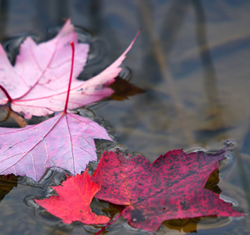 Winterizing
ponds can seem like an unpleasant task, almost as bad as taking
down the Christmas lights. But with a little preparation, winterizing
ponds can be a simple job done mainly in one day. Winterizing ponds
can also get expensive, but there are economical ways to keep your
plants and fish healthy during the winter season.
Winterizing
ponds can seem like an unpleasant task, almost as bad as taking
down the Christmas lights. But with a little preparation, winterizing
ponds can be a simple job done mainly in one day. Winterizing ponds
can also get expensive, but there are economical ways to keep your
plants and fish healthy during the winter season.
If money is not an issue when winterizing ponds, then you will first
want to purchase a pond heater and deicer. These are very important
to keep the water in your pond from falling below a freezing temperature,
thus killing off your fish and plants. The deicer will help to melt
the ice allowing oxygen to get into the water. If ice completely forms
over the top of the pond, then oxygen will not be allowed to circulate.
You might look into getting a deicer that has an aerator attached
to it. It will be more difficult for oxygen to make its way to the
bottom of the pond during winter. An aerator will help circulate the
water so that the oxygen at the top gets to the bottom of the pond.
This will also help keep the water at warmer temperatures.
If money is an issue, then there are less expensive ways of doing
something similar. If you leave a large plastic ball on the surface
of the water, the motion of the ball will aide in keeping a part of
the water from freezing. This will allow oxygen to get to your plants
and fish. You can also go out every day and break up the ice. If you
live in a very cold place and are expecting below freezing temperatures
for long periods of time, then it would probably be wise to purchase
a pond heater.
Besides heaters and deicers, there are other winterizing issues you
should consider. First, you will want to cover your pond with netting,
preventing leaves and other debris from falling into the pond during
autumn and winter. You will also want to consider feeding your fish
a different kind of food. A lighter diet will help prevent the fish
from leaving too much waste. This will help keep your water at safer
ammonia levels until spring. If your water falls below 40 degrees
Fahrenheit, then you should stop feeding your fish as they will be
in a state similar to hibernation. The fish will be able to live off
of what they have eaten over the summer.
Some other preparations for winterizing ponds that you will want
to do are cleaning the pond thoroughly, cutting back or discarding
plants that will not winter over, and adding special salts or bacteria
that will work during the winter. If you have a filter and will be
running the pump all winter long, then you will want to take the filter
liners out. Ice can form on the liners keeping the pump from working.
Check the hoses occasionally to make sure they haven’t frozen
over.
As the winter progresses, you will want to periodically check your
equipment to make sure it’s working properly. You will also
want to check on your fish and make sure the surface of the water
isn’t completely iced over. By following the above suggestions
for preparation and regular check-ups of your pond, winterizing your
pond will be a much easier task.